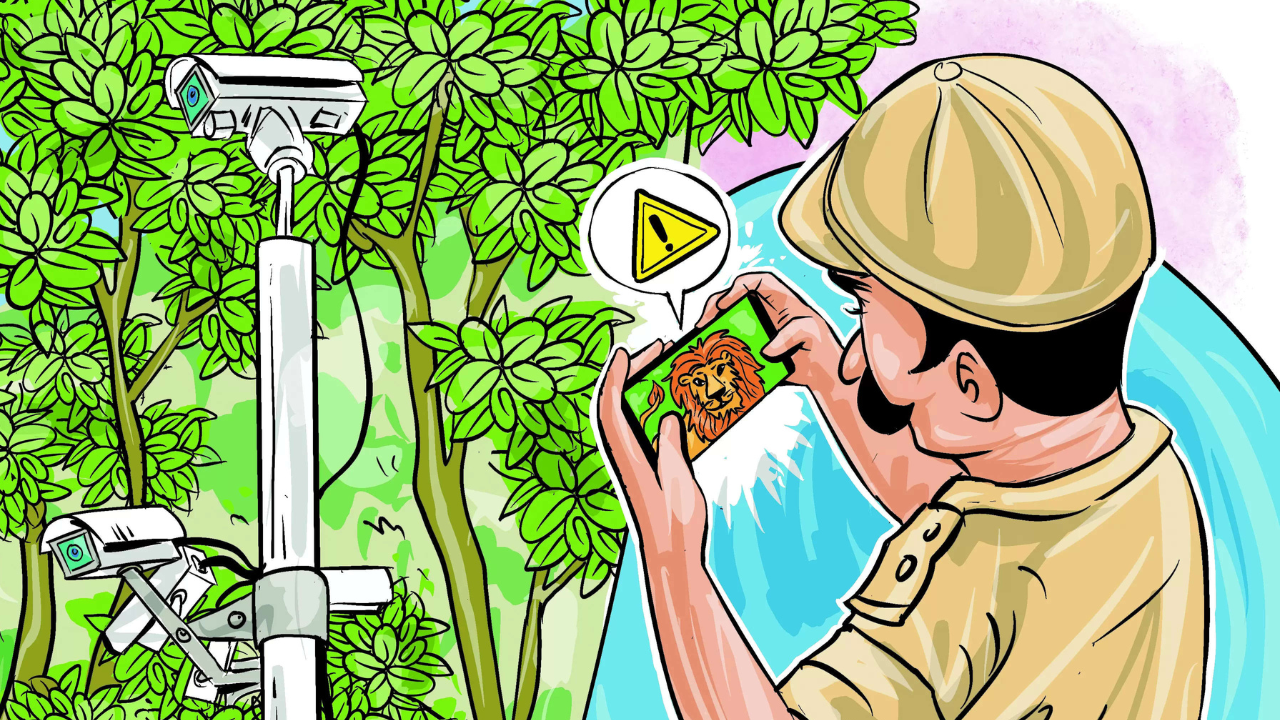AHMEDABAD: Attacks in the fields, livestock being killed – instances of man-animal conflict have remained a cause of concern in Saurashtra. Although villagers rely on CCTV camera footage to know about presence of big cats and other wild animals in their area, the current mechanism is unable to send them instant alerts, which are key to avoid close encounters with the wild.
Researchers from Charusat University worked on an IoT-based solution which, they say, will bridge time gap and send real-time alerts to villagers on their mobile phones about which animal is around. The research paper ‘Wild Animal Detection Using YOLOV8’, by Brahm Dave, Meet Mori, Anurag Bathani and Parth Goel states that the YOLOV8 architecture, part of the You Only Look Once (YOLO) series of object detection models, has been adapted to detect lions, tigers, leopards and sloth bears. And an IoT device linked to the camera then instantly relays this information to mobiles.
‘Accuracy rate of new model is 94.3%’
Meet Mori, one of the researchers, said, “People living on forest peripheries face many challenges in the form of man-animal conflict. I am from Junagadh and know how serious the issue is. The state forest department also says that conflicts have resulted in the loss of lives among people and substantial livestock losses. Various govt initiatives have been implemented to track and monitor wild animals.”
The researchers say that currently a person must remain in the control room to monitor CCTV footage and record movement of big cats. The new model eliminates this as the CCTV camera will identify accurately and send instant alerts straight to mobile phones, telling users if there is a big cat or a bear near their village or farm.
The deep learning architecture has been ‘taught’ to identify wild animals through an exhaustive data set of 1,619 images. The images have been collated from documentaries, YouTube videos and existing datasets. The model gives up to 94.3% accuracy, say researchers. Mori said more datasets can be added tune the model further to reduce false detection. He said that the research can be incorporated with the CCTV cameras using the IoT. Mori said the team is currently finalizing the hardware.
Forest department officials said, “These days, we see many CCTV footage of lions, which means that several villages have installed surveillance cameras. This model can help villagers get real-time updates and alerts on their phones. All they need to do is incorporate an IoT device into the surveillance infrastructure.”
Researchers from Charusat University worked on an IoT-based solution which, they say, will bridge time gap and send real-time alerts to villagers on their mobile phones about which animal is around. The research paper ‘Wild Animal Detection Using YOLOV8’, by Brahm Dave, Meet Mori, Anurag Bathani and Parth Goel states that the YOLOV8 architecture, part of the You Only Look Once (YOLO) series of object detection models, has been adapted to detect lions, tigers, leopards and sloth bears. And an IoT device linked to the camera then instantly relays this information to mobiles.
‘Accuracy rate of new model is 94.3%’
Meet Mori, one of the researchers, said, “People living on forest peripheries face many challenges in the form of man-animal conflict. I am from Junagadh and know how serious the issue is. The state forest department also says that conflicts have resulted in the loss of lives among people and substantial livestock losses. Various govt initiatives have been implemented to track and monitor wild animals.”
The researchers say that currently a person must remain in the control room to monitor CCTV footage and record movement of big cats. The new model eliminates this as the CCTV camera will identify accurately and send instant alerts straight to mobile phones, telling users if there is a big cat or a bear near their village or farm.
The deep learning architecture has been ‘taught’ to identify wild animals through an exhaustive data set of 1,619 images. The images have been collated from documentaries, YouTube videos and existing datasets. The model gives up to 94.3% accuracy, say researchers. Mori said more datasets can be added tune the model further to reduce false detection. He said that the research can be incorporated with the CCTV cameras using the IoT. Mori said the team is currently finalizing the hardware.
Forest department officials said, “These days, we see many CCTV footage of lions, which means that several villages have installed surveillance cameras. This model can help villagers get real-time updates and alerts on their phones. All they need to do is incorporate an IoT device into the surveillance infrastructure.”
Instant Alerts for Wild Animal Detection in Saurashtra | Mobile Phone | Ahmedabad News
